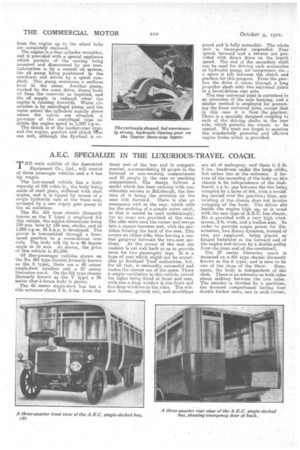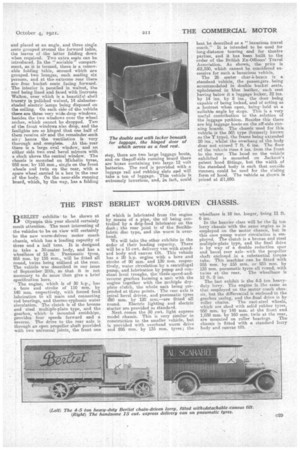A.E.C. SPECIALIZE IN THE LUXURIOUS-TRAVEL COACH.
Page 16

Page 17

If you've noticed an error in this article please click here to report it so we can fix it.
THE main exhibit of the Associated Equipment Co., Ltd., will cansist of three passenger vehicles and a 4 ton tip wagon.
The last-named vehicle has a body capacity of 100 cubic ft., the body being made of steel plate, stiffened with steel angles, and it is tipped by means of a single hydraulic ram at the front end, actuated by a new rottary gear pump in the oil container.
The No. 501 type -chassis (formerly known as the Y type) is employed for this vehicle, the engine dimensions being 120 ram. bore by 150 ram. stroke, and at 1,000 r.p.m. 45 b.h.p is developed. The power as transmitted through a f ourspeed gearbox to a worm-driven rear axle. The body will tip toot 40 degree angle in 30 secs. As shown, the price of this vehicle is £1,550.
Of thes passenger vehicles shown on the No. 401 type chassis( formerly known as the S type), there are a 40 seater single-deck omnibus and a 27 seater limousine coach. On the 501 type chassis (formerly known as the Y type) a 26 seater char-k-banes body is shown.
The 40 seater single-deck bus has a side entrance about 3 ft. 5 ins. from the
front end., of the bus and is compartmented, accommodating 22 people in the forward or non-smoking compartment and 18 people in the rear or smoking compartment. The design follows a model which has been running with conaiderabIe success in Edinburgh, the feature of it being the entrance on the near side forward. There is also an emergency exit at the rear, which calls for the undoing of aaeimple extra. catch, so that it cannot be used -unthinkingly, for no steps are provided at the rear. The side seats turn the corner and merge into a square traverse seat., with the partition forming the back of the seat. This occurs on either side, thualeaving a central gangway between the twoaseat sec tions. At the corner of the seat. the cushion is cut well back so as to provide room for two passengers' legs. It is a type of seat which might not be acceptable to Scotland Yard authorities, but, for all that, is eminently successful and makes the utmost. use of the space. There is ample ventilation in this vehicle, swivel fan lights being fitted at front and rear, with also a drop window in the front and five drop windows at the sides. The win. dew frames, garnish rail, and mouldiegs are all of mahogany, and there is 6 ft. 4 ins. headroom under the hoop. sticks, but rather less at the entrance. A feature Of the mounting of the body on this . chassis is its independence of the dashboard, x e in, gap between the two being occupied by a layer of felt, with a moulding carried over the junction; thus, any twisting of the. chassis does not involve wringing of the body. The driver sits beside the engine high up, as is usual with the new type of A.E.C. bus chassis. He is provided with a very high windscreen, 3 ft. wide, and a bucket seat. In order to provide ample power for illumination, two Rotax dynamos, instead of One, are employed, being placed on hinged bedplates at the forward end of the engine and driven by a doable, pulley from the front end of the crankshaft.
The 27 seater limousine coach is mounted on a 401 type chassis (formerly known as the S type), and is sure to be one of the clous of the Show. Here, again, the body is independent of the dash. Thera is an entrance on both sides about midway between the two axles. The interior is divided by a partition, the forward compartment having four double bucket seats, one in each corner, and placed at an angle, and three single seats grouped around the forward table, the leaves of -the latter folding down when required. Two extra seats can be introduced. In the "sociable" compartment, as it is termed, there is a removable folding table, around which are grouped, two louni:ves, each seating six persons, and at the --extreme rear there are. four bucket seats facing forward. The interior is panelled in walnut, the roof being lined and faced with lincrusta, Walton, over which is a. beautiful-shell tracery in polished walnut, 14 alabastershaded electric lamps being disposed on the ceiling. On each side of the vehicle there are three very wide drop windows. besides the two windows over the wheel arches, which cannot be dropped. Two of the front windows also drop, and the fanlighte are so hinged that one half of them receive air and the remainder .emit air hence the ventilation is very thorough and ,complete. At the, rear there is a. large oval window, and on either side two oval bevel mirrors with a clock above the central window. The chassis is mounted on Michelin tyres, 955 mm. by 155 nam., single on the front wheels and twin on the rear, with a spare wheel carried in a box in the rear of the, body. On the near-side running board, which, by the way, has a folding step, there are two large luggage boots, and on thepaff-side running board there are boxes containing two large 12 volt batteries. The roof is provided with a luggage rail and rubbing slats cad will take a ton of luggage. This vehicle is extremely luxurious, and, in fact, could best be described as a " luxuriou.s travel coach." It is intended to be used for long-distance. touring and for theatre parties, and it has been built to the order of the British Ex-Officers' Travel Association. As shown, the price is £2,350, which cannot be considered excessive for such a luxurious vehicle.
The 26 seater char-à-banes is a standard vehicle, the passengers being accommodated in double bucket seats, upholstered in blue leather, each seat having below it a luggage locker, 32 ins. by 14 ins. by 8 ins., the door being capable of being locked, and of acting as a footrest -when open, being. held at 'suitable angle by stops. This is a very -useful contribution to the solution of the luggage problem. Besides this there are big luggage boots on the off-side running boards. The chassis used for this vehicle is the 501 type (formerly known as the Y type), the frame being extended 20 ins., whilst the overhang of the body does not exceed 7 ft. 6 ins. The floor of the vehicle rises 4 ins, from the front to the rear. The hood on the vehicle exhibited is mounted. on Jackson's patent hood fittings, but tire width of the standard body is such that outside runners could be used for the sliding form of hood. The vehicle as shown is priced at £1,850.
















































